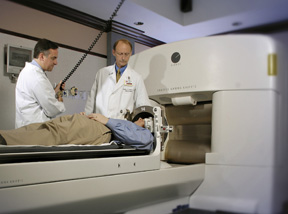One year ago UAB became the first medical center in the United States to offer the speedier cancer radiation therapy known as RapidArc, a next-generation, intensity-modulated radiation therapy.
 |
| Radiosurgeons John Fiveash (left) and Barton Guthrie treat a cancer patient using the Gamma Knife, one of three cutting-edge machines at UAB physicians have to treat patients. |
“For many tumor sites RapidArc has produced high-quality treatments that can be completed in much shorter treatment times than previous therapies,” Fiveash says.
“This has led to better patient comfort with treatment. We expect further refinement in the future will enable more patients to benefit from this technology.”
A team of Radiosurgery Program physicians administer RapidArc using a Varian iX linear accelerator. The technology enables physicians to deliver high-energy X-ray beams precisely to the tumor targets throughout the body eight times faster than previous models. The new technique can turn a 20-minute radiotherapy session into a 90-second session for selected patients.
The faster radiation delivery times reduce the chances that a slight move will affect the accuracy of the radiotherapy targeting, and it means patients spend less time – and feel less discomfort – in the treatment room.
“Knowing that we can reduce delivery times to less than two minutes per day is important considering the toll that cancer care takes emotionally and physically,” Fiveash says.
Experience counts
The UAB Radiosurgery staff has a 16-year track record of providing groundbreaking cancer treatment — such as RapidArc — to its patients.
From the outset, UAB chose to develop a multidisciplinary approach to the treatment of patients with complicated tumors requiring stereotactic radiation therapy. The Radiosurgery Program, which is part of the UAB Comprehensive Cancer Center, has successfully integrated sub-specialized faculty and staff from the departments of Radiation Oncology and Surgery.
This includes Fiveash and Barton Guthrie, M.D., director of the UAB Gamma Knife and Radiosurgery Center and director of Computer-Assisted Neurosurgery (CANS).
“You can have a new program in which people are learning how to do things, or you can receive treatment from the people that know how to do it,” says John Brinkerhoff, executive administrator of Radiation Oncology. “Experience counts. Our physicians have worked together for a long time, and this is a stellar program — far advanced when compared with anything available in the Southeast.”
Treating cancer since 1992
Stereotactic radiosurgery is a highly precise form of radiation therapy initially used to treat tumors and other abnormalities of the brain. Despite its name, stereotactic radiosurgery is a non-surgical procedure that uses highly focused X-rays to treat certain types of tumors and inoperable lesions, as a post-operative treatment to eliminate leftover tumor tissue or to obliterate abnormal blood vessels in congenital arteriovenous malformations.
The Gamma Knife treatment involves the delivery of a single high dose — or sometimes smaller, multiple doses — of radiation beams that converge on the specific area of the brain in which the tumor or other abnormality resides. Using a helmet-like device that keeps the head completely still and three-dimensional, computer-aided planning software, stereotactic radiosurgery minimizes the amount of radiation to healthy brain tissue.
UAB treated the first patient in Alabama with stereotactic radiosurgery in April 1992 with a multidisciplinary team including neurosurgeons and radiation oncologists.
Physicians use three cutting-edge technologies to treat patients:
- The Gamma Knife at UAB Highlands is used for cranial radiosurgery. UAB’s Gamma Knife is the fifth-busiest in the country and had treated more than 3,827 patients by 2008, qualifying it as one of the most experienced programs in the nation.
- TheTomoTherapy unit at the Comprehensive Cancer Center at Acton Road, the first clinically available, CT-based image-guidance platform for radiation therapy, gives physicians the ability to image a tumor immediately before its use. TomoTherapy greatly enhances targeting precision and increases the physicians’ ability to treat complicated tumors with radiation.
- The Varian iX, with RapidArc, also includes CT-based image-guidance. This provides the physician with the location changes and tumor size on a daily basis and enables them to optimize the treatment and provide comfort.
All patient-treatment plans are designed and evaluated by a multidisciplinary team of experienced radiation oncologists, neurosurgeons and physicists.
“If someone is pointing a radiation device at you, you want them to have the most advanced knowledge base and the skill to control that beam precisely and deliver the right amount of radiation to the tumor so it will do no harm to the rest of your body,” Brinkerhoff says.
“You want knowledge, experience and skills. We have a team that possesses these qualities.”
“Our goal as physicians is to create the optimal outcome for our patients with minimal risk,” Guthrie adds. “That will continue to drive our interest and development — not just the technology. You can buy technology, and if there were a superior technology available we would have it.
“It’s more about how you use the technology you have, how you study it and how you make your decisions using it. That’s where I think we have a substantial advantage.”
For more information about the UAB Radiosurgery Program:
Department of Radiation Oncology: www.uabradonc.com
Division of Neurosurgery: www.uab.edu/neurosurgery.